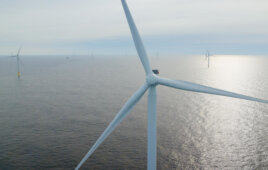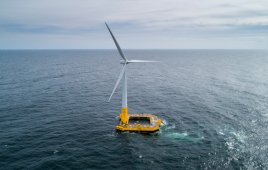This article comes from law firm K&L Gates and is authored by Zachary P. Ferreira, Darrell L. Conner, Barry M. Hartman, David L. Wochner and Michael L. O’Neill
President Donald Trump issued an executive order on April 28, 2017, that directs federal officials to review, potentially modify, and in some cases revoke or rescind policies affecting U.S. offshore energy development. Titled “Implementing an America-First Offshore Energy Strategy,” the executive order attempts to increase lease sales for federal lands on the Outer Continental Shelf (OCS), mandates review or reconsideration of federal regulatory requirements for offshore energy development and production, limits the establishment of marine sanctuaries, and requires a review of marine sanctuaries and marine national monuments from the previous 10 years.
President Trump’s executive order does not have a direct or immediate impact on offshore energy development, but it does start the process that may result in removing limitations that the Obama Administration established for offshore energy exploration and production and other commercial uses of OCS resources. Interested stakeholders can participate in this process by commenting in any rulemaking processes to revoke or reconsider federal regulations affecting energy development on the OCS. Additionally, impacted parties should anticipate, and may consider participating in, litigation challenging President Trump’s efforts.
Background

More scenes like this could be possible in U.S. waters thanks to Executive Orders from President Trump.
The U.S. Government manages energy and other mineral exploration and development on the OCS pursuant to a 1953 statute, the Outer Continental Shelf Lands Act (OCSLA). Acting pursuant to this authority, as well as authority under other federal laws like the National Marine Sanctuaries Act and the Antiquities Act, President Barack Obama established several regulatory programs during his eight years in office that limited or eliminated energy exploration and production and other commercial activities on portions of the OCS. The Obama Administration removed portions of the OCS from all mineral leasing, including offshore oil, gas, and sulfur leasing, and designated OCS lands as National Marine Sanctuaries or Marine National Monuments.
A frequent issue on the campaign trail, President Trump has stated repeatedly his intent to encourage additional domestic energy production to bolster U.S. energy security. As outlined below, his April 28 executive order initiates the process to remove some of the obstacles to offshore exploration and production put in place by the Obama Administration.
Executive order
The executive order states that “[i]t shall be the policy of the United States to encourage energy exploration and production, including on the [OCS]” while balancing energy production and energy security needs against “safe and environmentally responsible production.” The order proposes to implement this policy by reviewing and eliminating certain Obama-era limitations on offshore energy leasing and by reconsidering, and possibly revoking, federal rules and guidance that impose new regulatory obligations on companies engaged in offshore energy development.
Removing Limits on Offshore Energy Leasing First, the executive order directs the U.S. Secretary of the Interior to “give full consideration to revising the schedule of proposed oil and gas lease sales” in seven OCS Planning Areas: Western Gulf of Mexico; Central Gulf of Mexico; Chukchi Sea; Beaufort Sea; Cook Inlet; Mid-Atlantic; and South Atlantic. The order also directs the Secretary of Commerce to streamline regulatory permitting process for privately funded research and collection of seismic data to determine the offshore energy resource potential within OCSLA planning areas. In areas like the Mid-Atlantic Planning Area where exploration activities have been curtailed by previous administrations, this permitting initiative in conjunction with other aspects of the executive order could provide significant opportunities for the oil and gas industry.
Second, the executive order prohibits the Secretary of Commerce from “designating or expanding any National Marine Sanctuary” unless the Secretary of the Interior provides an accounting of “any energy or mineral resource potential within the designated area” and an analysis of how the designation will affect the development of those resources. The order also directs the Secretary of Commerce, working with the secretaries of Defense, the Interior, and Homeland Security, to review all designations or expansions of National Marine Sanctuaries or Marine National Monuments in the past 10 years. This review should consider the budgetary impact of managing each sanctuary or monument, the consultations of federal, state, or tribal consultations prior to the designation or expansion of each sanctuary or monument, and the opportunity costs these designations or expansions create by limiting potential energy or mineral exploration from these OCS areas. The Secretary of Commerce must report the results of this review within 180 days.
Third, President Trump’s executive order rescinds previous efforts to remove certain offshore lands from energy and mineral leasing programs. The executive order revokes Executive Order 13754, entitled “Northern Bering Sea Climate Resilience,” President Barack Obama’s order withdrawing portions of the Bering Sea from offshore energy leasing programs. The April 28 order also revokes President Obama’s withdrawals of certain offshore lands from offshore energy development, including the North Atlantic and Mid-Atlantic Planning Areas and the Chukchi Sea and Beaufort Sea Planning Areas in the Arctic.
Reviewing and Revoking Regulations on Offshore Energy Development The executive order initiates steps to review, and possibly revoke, withdraw, or modify federal regulations, proposed rules, and regulatory guidance affecting offshore energy exploration and production. The order requires a review of the following regulatory actions:
- Department of the Interior’s final rule addressing exploratory drilling on the Arctic OCS;
- Bureau of Safety and Environmental Enforcement’s blowout preventer and well control final rule, developed in response to the 2010 Deepwater Horizon oil spill in the Gulf of Mexico;
- Bureau of Ocean Energy Management’s (BOEM) proposed rule regarding air emissions measurements and control for oil, gas, and sulfur operations on the OCS;
- BOEM’s Notice to Lessees No. 2016-N01, requiring that BOEM consider 100% of the cost of OCS lease or right-of-way decommissioning to determine financial security requirements; and
- National Oceanic and Atmospheric Administration’s Technical Memorandum NMFS-OPR-55, in particular reconsidering this technical memorandum regarding the impact of human-made sounds on the hearing of marine mammals for consistency with the Trump Administration’s policy of encouraging safe and environmentally responsible offshore energy exploration and production.
Finally, the executive order directs the secretaries of Commerce and the Interior to “expedite all stages of consideration of Incidental Take Authorization requests, including Incidental Harassment Authorizations and Letters of Authorization, and Seismic Survey permit applications” under the Marine Mammal Protection Act.
Implications
The executive order provides an important signal that the Trump Administration will encourage energy and other commercial development on the U.S. OCS. Indeed, with an order signed by Secretary of the Interior Ryan Zinke on May 1, 2017, the Department of the Interior has started implementing the executive order’s policy directives. However, with limited exceptions, the actions that the executive order outlines will have minimal immediate impact on the development of energy resources on the OCS. The process of modifying the Obama Administration’s limits on offshore energy production and other limits on commercial uses of the U.S. OCS in many instances will require that agencies comply with federal rulemaking procedures, including public notice and opportunity for public comment. These processes will take months, even years, and likely will invite litigation from opponents to offshore energy exploration and production. Environmental groups have already filed suit challenging President Trump’s revocation of President Obama’s withdrawal of OSC lands in the Atlantic and Arctic Oceans. Likewise, some stakeholders very likely will challenge President Trump’s authority to rescind past designations of National Marine Sanctuaries or Marine National Monuments.
These regulatory and court processes offer interested stakeholders a way to present their views to federal decision-makers. With a lengthy regulatory and courtroom fight on the horizon, stakeholders should monitor these developments closely in order to develop and implement a proactive strategy to shape the outcome of these policy deliberations.
Filed Under: Offshore wind, Policy





